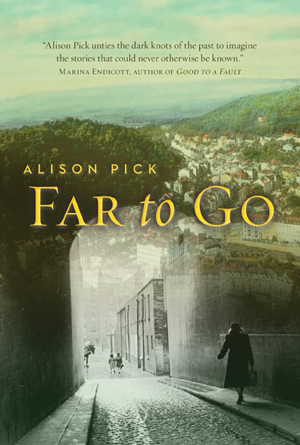 Reading the Longlist
Reading the Longlist
File Under:
Mystery Narrator
Far to Go
by Alison Pick
Review by Brian Rozendal
The Holocaust is one of those slam dunk issues for writers. And indeed, Booker Prize finalist Alison Pick has a compelling story to tell. Her third book, Far to Go, follows the efforts of Pavel and Anneliese Bauer, a young Jewish couple representing the hard-earned culture and wealth of a new Czechoslovakia in the late 1930's, as they try to flee during the Nazi occupation. Historical fiction provides a special opportunity for writers and readers: to recreate a slice of history that can otherwise seem like a natural progression of events. We get the color, texture, and surprise of those who witnessed it. Good writing can give you these gifts, little reminders that people and situations constantly surprise you, whether for good or bad.
Unfortunately, there are very few surprises in Far to Go. Pick has wonderful material for her story, and it's clear she's done her homework. She tastefully drops in little details that help enliven a scene, give historical context, and recreate a world that has been sadly lost. She knows how to paint a picture with just enough description for us to fill in the gaps. But when it comes to the story and main characters, Pick writes as if she doesn't trust either the story or the reader. She tries to entice us with various mysteries about the characters. What is the secret between Anneliese and the nanny that causes so much animosity—and love—between them? Is Pavel's right hand man really a Nazi spy? Is Anneliese cheating on Pavel with a Nazi soldier? Who can be trusted? The grand mystery, though, is: Who is narrating?
The book is divided into five parts, but it’s also divided into eight chapters that are again divided into two or three sections. This confusing and unnecessary structure is perhaps designed to rattle us readers out of our torpid stupor. (Or perhaps we’re just not ready for this new type of numbering.) Almost every chapter opens with a letter from some character we either haven't met (or have but don’t find central) to another character with the same criteria. At the bottom of the letter we get instructions such as, “FILE UNDER: Bauer, Lore. Died Birkenau, 1943.” Early in the novel, we get an undated letter from Anneliese to her husband Pavel. Included at the bottom of this letter is “FILE UNDER: Bauer, Anneliese. See Bauer, Pavel, for details.” What happened to Anneliese? It's another mystery. Further, following each letter we get yet another letter—undated, unaddressed, and unsigned—from someone (?) to someone else (??). Further mystery yet.
The third section of each chapter is where most of the action happens. For the majority of the book, this unfolds through the eyes of Marta, the Bauers’ nanny, as she obsessively “overhears” the Bauers’ lives. Marta is neither likeable nor relatable, although she does seem to be an even more effective snoop than some of the Nazi sympathizers in the story. About two thirds of the way through the novel, the focus shifts from Marta to the Bauers’ six year old son, as the mystery narrator relates the boy’s travels on the Kindertransport out of Czechoslovakia. For readers who make it to the end, the author reveals everything. Spoiler alert: the narrator is not who you think it is. By the time you’ve endured the book’s structural and narrative frustrations to get there, though, you may no longer care. ΩBrian Rozendal has written, most recently, about the impact Victorian measures of longitude had on representations of time travel in literature.


